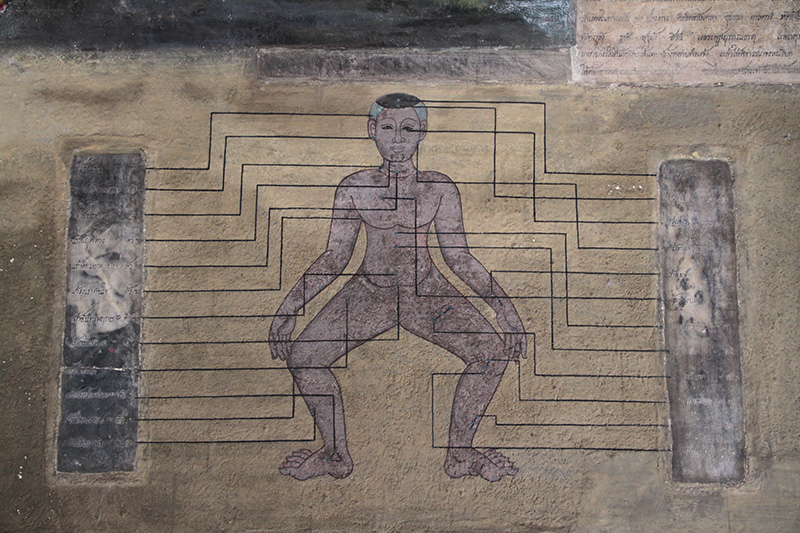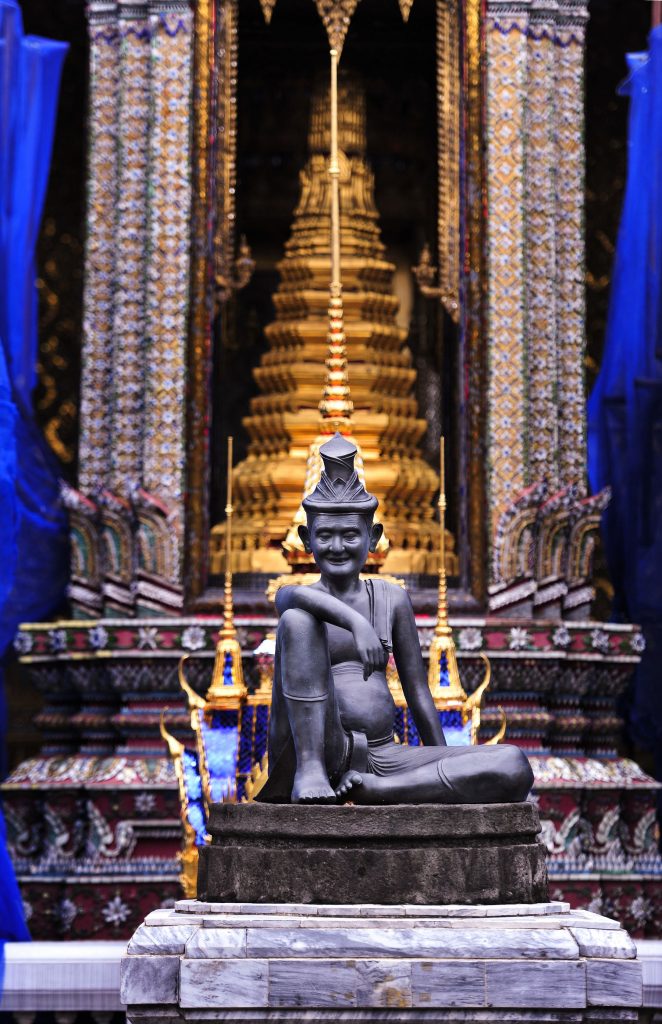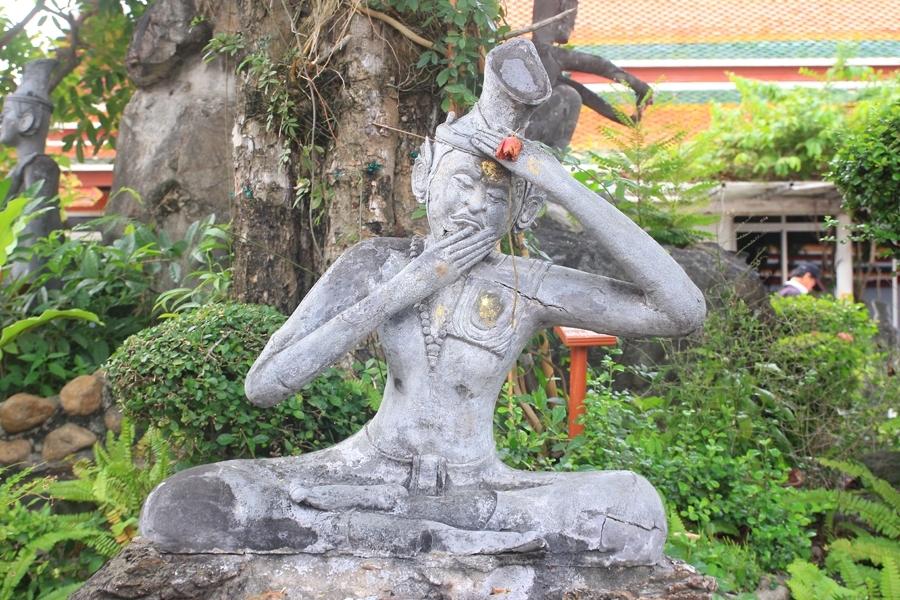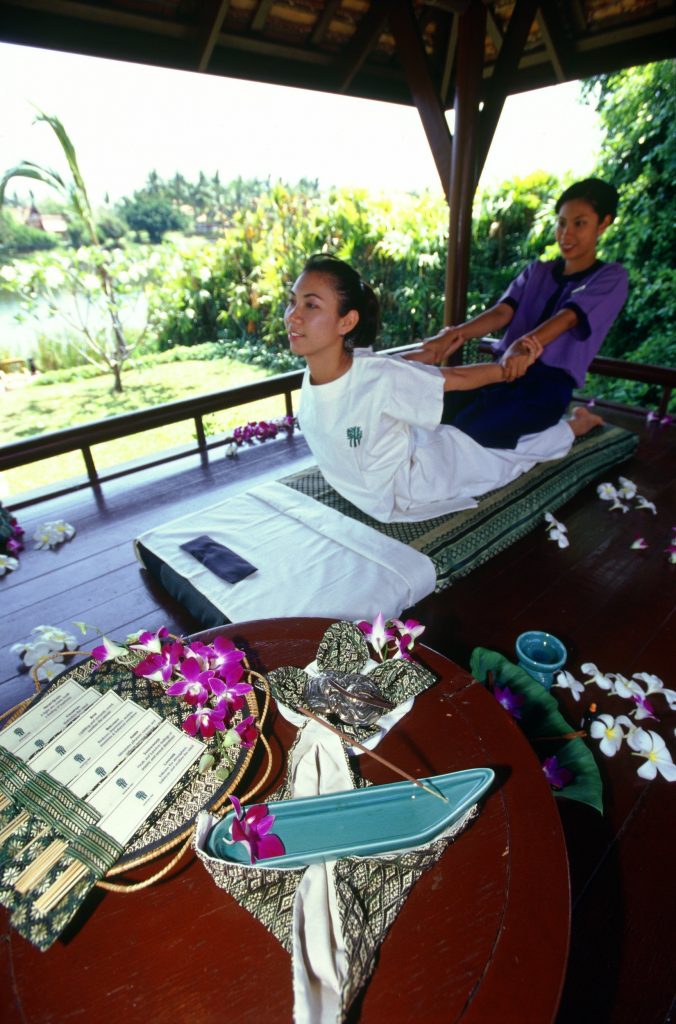Nuad Thai: Thai Massage – a UNESCO Intangible Cultural Heritage

Nuad Thai pressure points diagram, Wat Pho, Bangkok (cr. Museum Siam)
Thai Massage, known in Thai as Nuad Thai, is a traditional form of manual therapy that utilizes pressure, compression, and rubbing, to boost blood circulation, reduce muscular soreness, and ease the aches and pains of conditions such as insomnia, depression, rheumatism, Parkinson’s, and Office Syndrome. Often, fragrant herbs and spices are part of the massage, creating a blissful therapeutic session that blends the benefits of carefully applied pressure with just the right amount of olfactory stimulation. A Thai massage is so effective that a common response after a session is only the thirst to return for more.
Thai massage seems so much like a panacea that the French envoy to the Ayutthaya Kingdom once described Thai massage as a treatment where “the sick were compressed and stretched, and the pregnant were treated to deliver their babies with ease.”
Herbs and Spices
As with the majority of traditional medicine, certain herbs and spices are believed to alleviate certain symptoms. The formulation of compression balls, filled with herbs and spices, often takes into account what the patients’ specific symptoms are. For instance, massage therapists know to use Bengal root, a relative of the ginger, to reduce soreness and inflammation; kaffir lime zest, which contains fragrant volatile essential oils, to reduce dizziness; lemongrass, to induce sweating to get rid of toxins; tamarind leaves to nourish the skin and reduce dryness and itchiness; soap pod wattle to nourish the skin and relieve irritation; turmeric to nourish the skin and ease any skin condition; salt to reduce heat and helps bring out the benefits of other herbs; and camphor, which contains essential oils, to give a pleasant scent and to aid heart functions.
Pandan leaves, kaffir lime zest, pomelo zest, Java ginger, galangal, and eucalyptus, are also popular ingredients of Thai massage.
Jivaka Komarabhacca and the Origins of Thai Massage

Statue of Sage Jivaka Komarabhacca, Wat Phra Kaew, Bangkok (cr. TAT)
The origins of Thai massage stems from the Indian subcontinent, during the Buddha’s lifetime. Jivaka Komarabhacca, King Bimbisara’s and later the Buddha’s physician, is considered to be founder of the Hermit Exercise (rusee dad-ton), a set of postures at the core of Thai massage. Jivaka studied medicine in the city of Takkasila (also known as Taxila or Takshashila) and was known for treating his patients with dignity, compassion, and fairness, making him well-loved by the community. (As a faithful Buddhist, he attained the state of sotapanna, the first of the four stages of enlightenment in Buddhism.) He passed on his knowledge, which spread across the South and Southeast Asian regions.
Bringing Thai Massage to the Public, a Quick Look Throughout the Kingdoms
Originally, Thai massage was used only for nobility and royalty. The reign of King Ramkamhaeng the Great, who ruled the Sukhothai Kingdom from 1279 to 1298, produced a stone inscription containing details about the use of herbs in massage. Later, during the reign of King Narai the Great, who ruled the Ayutthaya Kingdom from 1656 to 1688, massage therapists were considered royal servants and themselves granted high ranks and land ownership.
Gradually, Thai massage, even before it became known as such, started to have its own distinct place in history. By the end of his reign, King Narai had ordered a collection of herbal recipes and treatments to be documented into a piece of text now known as Tamra Osot Phra Narai (King Narai’s Text of Herbal Medicine). The importance of this text, putting herbal medicines at the forefront of treatment, would later be echoed during the Rattanakosin Kingdom (1782–present), when Rama I (1782–1809) ordered a renovation of a popular temple, Wat Pho, a site that would become central to the preservation of Thai massage, to include a display of herbal medicine formulas, so that the public may also understand their use.
The reign of Rama III (1824–1851) then witnessed great leaps in making massage therapy more accessible to the public. In 1832 AD, Rama III issued a command for sixty murals documenting the therapies walls, to be on the walls of Wat Pho. He also commanded eighty statues exemplifying the Hermit Exercise to be built, and for a plot of land to grow rare medicinal herbs and spices, so that the public could visit and learn more about the arts of traditional medicine.

Hermit Exercise statue, Wat Pho, Bangkok (cr. Museum Siam)
Under the reign of Rama IV (1851–1868), Thai massage was spread to the south, where murals were drawn in the walls of Wat Klang, Songkhla province, with poetic captions. In the reign of King Rama V, medical texts were translated from Pali and Sanskrit into Thai and called The Royal Massage Manual. In the reign of King Rama VII (1868–1960), with a growing influence from the West, a clear distinction between “modern” and “traditional” medicine was made, placing Thai massage under the latter category.
Thai massage remains highly in-demand today, with more and more approved massage therapy schools having opened across the country during the reign of Rama IX (1946–2016). Seeing the popularity of Thai massage, Rama IX encouraged Wat Pho’s Chetawan Massage School, which by then had come into existence, to continue offering their four popular courses, while constantly improving on their standards to meet local and global demands and expanding their reach. The Chetawan Massage School now has four branches in Thailand: in Wat Pho, Chaeng Wattana, Salaya, and Chiang Mai.
Given the history of Thai massage, it may be unsurprising, perhaps, that there are now two styles of Thai massage: the royal style and the commoner’s style. The royal style was traditionally used to massage aristocrats and royalty. This type of massage is gentler and more elegant, using only hands, unlike the commoner’s style, which also employs the feet, knees, and elbows. The royal style also requires the recipient of the massage to either sit up or to lay on their backs or side, but never uncomfortably on their stomach. The commoner’s style, which is more likely what one gets requesting a Thai massage, can be less gentle, and, as aforementioned, in this style, the massage therapist may also use parts of his or her body viewed as a little less refined: feet, knees, and elbows. This is the style of massage featured at Wat Pho.
Thai Massage Through Education and Regulations
In 1982, Professor Uey Ketsing established the Ayurveda College for Traditional Medicine (which would later be integrated into the prestigious Siriraj Hospital’s programs of tertiary studies). Narongsak Bunratanahiran, a renowned therapist, taught Thai massage at the College. In 2001, the Thai Ministry of Health recognized Thai massage as a branch of traditional Thai medicine.
The Thai Ministry of Health requires that all students at schools of Thai massage meet a certain minimum number of contact hours before they can become licensed therapists. For example, at Wat Pho, students must take 153 hours to graduate from a basic massage therapy course and 380 hours for an intermediate one.
The study of Thai massage is popular not only in Bangkok, but also in Chiang Mai, where sixteen schools of massage are registered. Ninety percent of the students in each year are foreigners, speaking to the popularity of Thai massage in foreign communities.
Beyond Thailand and Thai Therapists

Thai Massage (cr. TAT)
Massage therapies bring in billions of Thai Baht in revenue each year, including from revenues earned internationally. In Europe and North America, Thai massage can make for particularly lucrative businesses, generating up to $8000 per month. In the United States, every massage therapist needs to carry a valid license issued by American authorities. These require aspiring therapists to participate in long, and sometimes costly, massage courses.
If the benefits of a Thai massage sound too good to be true, rest assured that practitioners are not under the illusion that a massage therapy is always the answer to a woe. Despite the benefits of a massage, there are times when therapists will request clients to wait first. Times and conditions particularly disadvantageous for a massage include: moments immediately after having a meal to more permanent diseases or medical setbacks – diabetes, osteoporosis, and some types of cancer, or high blood pressure, for instance – or being pregnant. In addition, those recently recovered from an accident or a bone fracture, or with open wounds or recently installed prosthetics also are discouraged from receiving any massages for one month after surgery.
Thai massage does work for a majority of people, in the majority of circumstances; however, since its main aim has always been to heal, Nuad Thai should happen only when a body is ready and can be optimally receptive.
References
Norraratphutthi, Kalyanamitr , “ [หัตถศาสตร์บาบัดโรค ภูมิปัญญาไทยดังไกลไปต่างแดน].” Watthanatham Journal: Department of Cultural Promotion, yr. 57, no. 3, July – September. 2018, pp. 62 – 67. Retrieved April 1, 2021. Link: http://magazine.culture.go.th/2018/3/mobile/index.html#p=65


